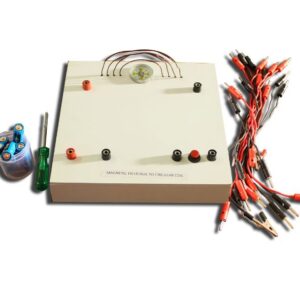TEMPERATURE AND RESISTANCE WORKING MODEL
SCIENCE LAB EQUIPMENT WORKING MODEL / SCIENCE EXHIBITION WORKING MODEL
5 in stock
TEMPERATURE AND RESISTANCE
Temperature and resistance are closely related in electrical circuits and materials. Here’s a simplified explanation suitable for school education in India:
**Temperature and Resistance Relationship:**
1. **Direct Relationship:** In most materials, including metals and semiconductors, resistance increases with an increase in temperature. This relationship is described by the positive temperature coefficient (PTC) of resistance.
2. **Explanation:** When the temperature of a material increases, the atoms and molecules within the material vibrate more vigorously, causing more collisions with free electrons. These collisions impede the flow of electrons, resulting in an increase in resistance. Conversely, when the temperature decreases, the atoms and molecules vibrate less, leading to fewer collisions and lower resistance.
**Practical Examples:**
1. **Incandescent Bulbs:** In incandescent light bulbs, the filament is made of tungsten, which has a high melting point. As current passes through the filament, it heats up, causing its resistance to increase. This increase in resistance limits the current flow and prevents the filament from overheating.
2. **Thermistors:** Thermistors are temperature-sensitive resistors whose resistance changes significantly with temperature. They are commonly used in temperature sensing and control applications, such as thermostats and temperature-compensating circuits.
**Formula for Temperature and Resistance:**
1. **Approximate Relationship:** The relationship between temperature (\( T \)) and resistance (\( R \)) in metals can be approximated by the following equation:
\[ R = R_0 x (1 + alpha x (T – T_0))]
Where:
– \( R \) is the resistance at temperature \( T \).
– \( R_0 \) is the resistance at a reference temperature \( T_0 \).
– \( \alpha \) is the temperature coefficient of resistance, representing how much the resistance changes per degree Celsius.
– \( T \) is the temperature in degrees Celsius.
**Demonstration:**
1. **Experiment:** Conduct an experiment to demonstrate the relationship between temperature and resistance using a simple circuit with a resistor and a multimeter.
2. **Procedure:** Measure the resistance of the resistor at room temperature using the multimeter. Then, heat the resistor using a heat source such as a hairdryer and measure the resistance again. Compare the two resistance values to observe the change in resistance with temperature.
**Conclusion:**
Teaching students about the relationship between temperature and resistance provides valuable insights into the behavior of electrical components and materials. It also lays the foundation for understanding more advanced concepts in electronics and thermal physics.
- Temperature Coefficient of Resistance:
- The temperature coefficient of resistance (�) is a measure of how much the resistance of a material changes with temperature.
- It is usually expressed in terms of percent change in resistance per degree Celsius change in temperature.
- Different materials have different temperature coefficients, and this coefficient can be positive, negative, or close to zero depending on the material.
- Effect of Temperature on Resistance:
- For most conductors, including metals like copper and aluminum, resistance increases with increasing temperature.
- This is because as temperature increases, the atoms in the conductor vibrate more vigorously, leading to greater collisions between electrons and atoms, which in turn increases resistance.
- Conversely, for some materials like semiconductors, resistance decreases with increasing temperature.
- Temperature Dependency Formula:
- The relationship between resistance (�), temperature (�), and the temperature coefficient of resistance (�) can be described by the formula:
��=�0×(1+�×(�−�0))
where �� is the resistance at temperature �, �0 is the resistance at reference temperature �0, and � is the temperature coefficient of resistance.
- The relationship between resistance (�), temperature (�), and the temperature coefficient of resistance (�) can be described by the formula:
- Applications:
- Understanding the temperature-resistance relationship is essential in the design and operation of electrical devices and circuits.
- It helps in selecting appropriate materials for conductors and resistors based on their temperature characteristics.
- It also helps in predicting and compensating for changes in resistance due to temperature variations in electronic systems.
In summary, temperature has a significant impact on the resistance of conductors and materials, with resistance typically increasing with increasing temperature. This relationship is quantified by the temperature coefficient of resistance and is important in various aspects of electrical engineering and circuit design.
| Weight | 0.5 kg |
|---|---|
| Dimensions | 25 × 25 × 5 cm |
You must be logged in to post a review.







Reviews
There are no reviews yet